Events on June 29, 2017

Dr. Maria Guillem, Universitat Politècnica de València in Spain Presents:
Contributions of Cardiac Electrophysiological models to patient management
June 29, 2017 at 12:00pm for 1hr
Evans Conference Room, WEB 3780
Warnock Engineering Building, 3rd floor.
Dr. Guillem was trained initially as a telecommunications Engineer (Universitat Politècnica de València/Polytechnical University of Valenica , UPV, 2003), and then pursued a Master’s in Biomedical Engineering (Northwestern University, NU, 2006) and her PhD in Electronics Engineering (UPV, 2009). She is not the deputy director of ITACA Research Institute at UPV, and head of the Cardiac Oriented Research Laboratory.
She was a Fulbright fellow at Northwestern University and currently is an Associate Professor at the Electronics Engineering Department at UPV. Dr. Guillem is co-author of 26 international scientific research papers, more than 100 conference papers or abstracts and three patents. Her research interests include the development of medical instrumentation and signal processing for the diagnosis and treatment of cardiac diseases.Abstract:
Electrophysiological models are powerful tools for cardiac electrophysiology since they allow for a deeper understanding of the mechanisms of arrhythmias and the action of drugs than possible with experiments alone. Models can also guide the development of new diagnostic and therapeutical approaches. In her talk, Dr Guillem will address the use of electrophysiological models from the cellular level to the whole patient both in the experimental and clinical settings and suggest how they can be used to improve patient management.
Posted by: Nathan Galli




